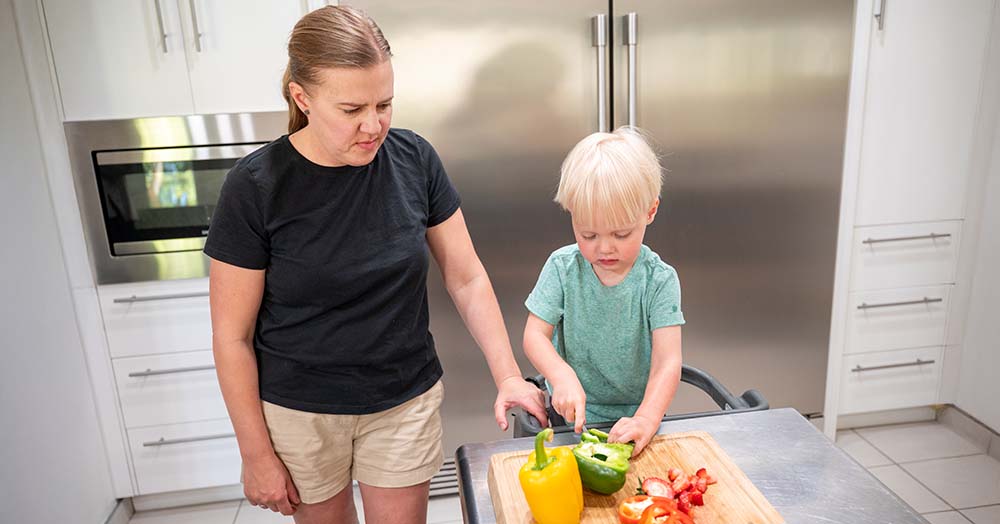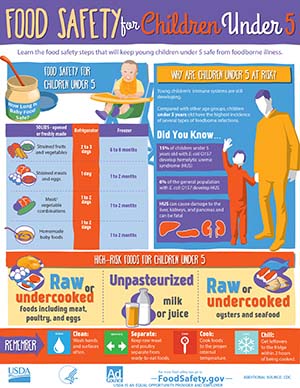
How often do you hear yourself asking this question? “How do I get my child to eat new foods?”
The answer? Start with play.
For babies and toddlers, food is not just about nutrients—it’s about exploration. Before they trust a new food enough to eat it, they often need to see it, touch it and even smell it several times. What might look like “messy” or “picky” behavior is actually an important part of how children learn to eat.
According to the USDA’s Infant and Toddler Nutrition guidelines, offering a variety of healthy foods and letting children decide what and how much to eat builds positive eating habits and supports healthy growth.
Helping kids try new foods without pressure
From a developmental perspective, sensory play is a key part of early learning. When children squish peas with their fingers, smell a spoonful of yogurt or rub a slice of mango on their lips before taking a bite, they’re not misbehaving—they’re gathering sensory information. Encouraging play is a powerful and underused tool in helping kids try new foods.
It helps them build trust in food. The Ellyn Satter Institute, a leading authority in feeding dynamics, explains this well:
“Fundamental to parents’ jobs is trusting children to determine how much and whether to eat from what parents provide. When parents do their jobs with feeding, children do their jobs with eating”.
– Ellyn Satter, MS, MSSW
How to use play to support new food exploration
At home, this might look like letting your toddler mash cooked sweet potato with their hands, smell a leaf of fresh basil or pretend to feed their stuffed animals some broccoli. Play doesn’t need to be elaborate. It just needs to be inviting and pressure-free.
Research from Zero to Three shows that children are more likely to accept new foods when they see caregivers eating the same foods with enjoyment. And, they are allowed to touch or play with them before eating. These strategies help build familiarity, and familiarity is key to reducing food refusal.
This is also an opportunity to lean into cultural foods. Babies and toddlers thrive when meals (and mealtimes) offer familiarity. A soft dosa, a spoonful of pozole or mashed black-eyed peas are not only nourishing—they’re familiar and comforting.
Responsive feeding sets a lifelong foundation
Mealtimes should be more about connection than correction. Responsive feeding—where caregivers offer healthy choices and children decide how much to eat—builds trust, autonomy, and positive associations with food.
Here are a few guiding principles that support this approach:
- Eat together to model healthy habits
- Offer a variety of foods over time
- Avoid pressure or rewards related to eating
- Allow your child to trust their body’s signals
When you create a safe space for exploration, you help children build lifelong habits that support health and joy at the table.
Addressing common feeding concerns
Parents frequently Google questions like:
- When should I start introducing solid food to my baby?
- Why won’t my toddler eat vegetables?
- Is it normal for my toddler to refuse food?
These are valid concerns. Let’s take them one at a time:
When to start solids: Around 6 months is the ideal time for most babies to begin solids—when they can sit up with support, show interest in food, and can move food from a spoon to the back of their mouth. Start with soft textures and gradually build variety.
Refusing vegetables: This is common and not a cause for alarm. Children may need 10 to 15 exposures before they accept a new food. Keep offering vegetables in different ways—roasted, steamed, added to familiar dishes—and let them explore without pressure.
Appetite ups and downs: Toddlers are growing more slowly than they did in infancy, and it’s perfectly normal for their hunger to fluctuate from day to day. Trust their appetite and avoid forcing them to take bites. Pressuring children to eat can make picky eating worse.
When to seek extra help
For some families, feeding challenges go beyond the usual picky phases. If your child:
- Frequently chokes or gags during meals
- Refuses entire food groups
- Is not gaining weight or growing as expected
- Shows signs of distress at every mealtime
These may be signs of a pediatric feeding disorder or sensory feeding difficulty. You are not alone, and help is available. The national nonprofit Feeding Matters offers education and support to families navigating more severe feeding issues.
Likewise, if you’re concerned about potential food allergies, especially during the introduction of early solids, it’s essential to stay informed about the latest research. The Food Allergy Research & Education organization shares evidence-based information on introducing allergenic foods early to help reduce risk.
And most importantly, talk with your child’s pediatrician or a registered dietitian trained in infant and toddler feeding. Trust your instincts—early support can make a big difference.





